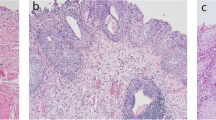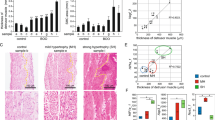Abstract
Partial bladder outlet obstruction (pBOO) is characterized by exaggerated stretch, hydrodynamic pressure, and inflammation which cause significant damage and fibrosis to the bladder wall. Several studies have implicated hypoxia in its pathophysiology. However, the isolated progressive effects of hypoxia on bladder cells are not yet defined. Sub-confluent normal human bladder smooth muscle cells (hbSMC) were cultured in 3% O2 tension for 2, 24, 48, and 72 h. RNA, cellular proteins, and secreted proteins were used for gene expression analysis, immunoblotting, and ELISA, respectively. Transcription of hypoxia-inducible factor (HIF)1α and HIF2α were transiently induced after 2 h of hypoxia (p < 0.05), whereas HIF3 was upregulated after 72 h (p < 0.005). HIF1 and HIF3α proteins were significantly induced after 2 and 72 h, respectively. VEGF mRNA increased significantly after 24 and 72 h (p < 0.005). The inflammatory cytokines, TGFB (protein and mRNA), IL 1β, 1L6, and TNFα (mRNA) demonstrated a time-dependent increased expression. Furthermore, the anti-inflammatory cytokine IL-10 was downregulated after 72 h (p < 0.05). Evidence of smooth muscle cell dedifferentiation included increased αSMA, vimentin, and desmin. Evidence of pro-fibrotic changes included increased CTGF, SMAD 2, and SMAD 3 as well as collagens 1, 2, 3, and 4, fibronectin, aggrecan, and TIMP 1 transcripts (p < 0.05). Total collagen proteins also increased time-dependently (p < 0.05). Together, these results show that exposure of hbSMC to low oxygen tension results in intense hypoxic cascade, including inflammation, de-differentiation, pro-fibrotic changes, and increased extracellular matrix expression. This elucidates mechanisms of hypoxia-driven bladder deterioration in bladder cells, which is important in tailoring in vivo experiments and may ultimately translate into improved clinical outcomes.




Similar content being viewed by others
References
Barton BE (1997) IL-6: insights into novel biological activities. Oct Clin Immunol Immunopathol(1):16–20
Bowen RS, Gu Y, Zhang Y, Lewis DF, Wang Y (2005) Hypoxia promotes interleukin-6 and -8 but reduces interleukin-10 production by placental trophoblast cells from preeclamptic pregnancies. J Soc Gynecol Investig 12(6):428–432
Chen CP, Yang YC, Su TH, Chen CY, Aplin JD (2005) Hypoxia and transforming growth factor-beta 1 act independently to increase extracellular matrix production by placental fibroblasts. J Clin Endocrinol Metab 90(2):1083–1090
Chen L, Wei TQ, Wang Y, Zhang J, Li H, Wang KJ (2012) Simulated bladder pressure stimulates human bladder smooth muscle cell proliferation via the PI3K/SGK1 signaling pathway. J Urol 188(2):661–667
Chouhan VS, Dangi SS, Babitha V, Verma MR, Bag S, Singh G, Sarkar M (2015) Stimulatory effect of luteinizing hormone, insulin-like growth factor-1, and epidermal growth factor on vascular endothelial growth factor production in cultured bubaline luteal cells. Theriogenology S0093-691X(15):00325–00328
Desmouliere A, Geinoz A, Gabbiani F, Gabbiani G (1993) Transforming growth factor-beta-1 induces alpha-smooth muscle actin expression in granulation tissue myofibroblasts and in quiescent and growing cultured fibroblasts. J Cell Biol 122:103–111
Dugina V, Fontao L, Chaponnier C, Vasiliev J, Gabbiani G (2001) Focal adhesion features during myofibroblastic differentiation are controlled by intracellular and extracellular factors. J Cell Sci 114(Pt 18):3285–3296
Falanga V, Qian SW, Danielpour D, Katz MH, Roberts AB, Sporn MB (1991) Hypoxia upregulates the synthesis of TGF-beta 1 by human dermal fibroblasts. J Invest Dermatol 97(4):634–637
Guillemin K, Krasnow MA (1997) The hypoxic response: huffing and HIFing. Cell 89:9–12
Hara S, Hamada J, Kobayashi C, Kondo Y, Imura N (2001) Expression and characterization of hypoxia-inducible factor (HIF)-3alpha in human kidney: suppression of HIF-mediated gene expression by HIF-3alpha. Biochem Biophys Res Commun 287(4):808–813
Heidbreder M, Fröhlich F, Jöhren O, Dendorfer A, Qadri F, Dominiak P (2003) Hypoxia rapidly activates HIF-3alpha mRNA expression. FASEB J 17(11):1541–1543
Higgins DF, Kimura K, Bernhardt WM, Shrimanker N, Akai Y, Hohenstein B, Saito Y, Johnson RS, Kretzler M, Cohen CD, Eckardt KU, Iwano M, Haase VH (2007) Hypoxia promotes fibrogenesis in vivo via HIF-1 stimulation of epithelial-to-mesenchymal transition. J Clin Invest 117:3810–3820
Howard PS, Kucich U, Coplen DE, He Y (2005) Transforming growth factor-beta1-induced hypertrophy and matrix expression in human bladder smooth muscle cells. Urology 66(6):1349–1353
Huber PA (1997) Caldesmon. Int J Biochem Cell Biol 29(8–9):1047–1051
Jiang X, Chen Y, Zhu H, Wang B, Qu P, Chen R, Sun X (2015) Sodium tanshinone IIA sulfonate ameliorates bladder fibrosis in a rat model of partial bladder outlet obstruction by inhibiting the TGF-β/Smad pathway activation. PLoS One 10(6):e0129655
Levin RM, Longhurst PA, Monson FC, Kato K, Wein AJ, Greenland JE, Brading AF (1990) Effect of bladder outlet obstruction on the morphology, physiology, and pharmacology of the bladder. Prostate Suppl 3:9–26
MacPherson BR, Leslie KO, Lizaso KV, Schwarz JE (1993) Contractile cells of the kidney in primary glomerular disorders: an immunohistochemical study using an anti-alpha-smooth muscle actin monoclonal antibody. Hum Pathol 24(7):710–716
Manotham K, Tanaka T, Matsumoto M, Ohse T, Inagi R, Miyata T, Kurokawa K, Fujita T, Ingelfinger JR, Nangaku M (2004) Transdifferentiation of cultured tubular cells induced by hypoxia. Kidney Int 65(3):871–880
Metcalfe PD, Wang J, Jiao H, Huang Y, Hori K, Moore RB, Tredget EE (2010) Bladder outlet obstruction: progression from inflammation to fibrosis. BJU Int 106(11):1686–1694
Neuman RE, Logan MA (1950) The determination of hydroxyproline. J Biol Chem 184(1):299–306
Norman JT, Clark IM, Garcia PL (2000) Hypoxia promotes fibrogenesis in human renal fibroblasts. Kidney Int 58(6):2351–2366
Pinggera GM, Mitterberger M, Steiner E, Pallwein L, Frauscher F, Aigner F, Bartsch G, Strasser H (2008) Association of lower urinary tract symptoms and chronic ischaemia of the lower urinary tract in elderly women and men: assessment using colour Doppler ultrasonography. BJU 102(4):470–474
Sánchez-Elsner T, Botella LM, Velasco B, Corbí A, Attisano L, Bernabéu C (2001) Synergistic cooperation between hypoxia and transforming growth factor-beta pathways on human vascular endothelial growth factor gene expression. J Biol Chem 276(42):38527–38535
Schröder A, Chichester P, Kogan BA, Longhurst PA, Lieb J, Das AK, Levin RM (2001) J Urol. Effect of chronic bladder outlet obstruction on blood flow of the rabbit bladder 165(2):640–646
Shi B, Zhu Y, Laudon V, Ran L, Liu Y, Xu Z (2009) Alterations of urine tgf-beta1 and bfgf following bladder outlet obstruction: a predictor for detrusor contractibility? Urol Int 82(1):43–47
Shi JH, Guan H, Shi S, Cai WX, Bai XZ, Hu XL, Fang XB, Liu JQ, Tao K, Zhu XX, Tang CW, Hu DH (2013) Protection against TGF-β1-induced fibrosis effects of IL-10 on dermal fibroblasts and its potential therapeutics for the reduction of skin scarring. Arch Dermatol Res 305(4):341–352
Shi YF, Fong CC, Zhang Q, Cheung PY, Tzang CH, Wu RS, Yang M (2007) Hypoxia induces the activation of human hepatic stellate cells LX-2 through TGF-beta signaling pathway. FEBS Lett 581(2):203–210
Yildirim A, Başeskioğlu B, Temel HE, Erkasap N, Yenilmez A, Uslu S, Ozer C, Ozkurt M, Dönmez T (2013) Effect of αlipoic acid and silymarin on bladder outlet obstruction. Exp Ther Med 5(2):596–602
Zheng Y, Chang S, Boopathi E, Burkett S, John M, Malkowicz SB, Chacko S (2012) Generation of a human urinary bladder smooth muscle cell line. Vitro Cell Dev Biol Anim 48(2):84–96
Acknowledgments
We acknowledge the Northern Alberta Urology Foundation for funding this project.
Author information
Authors and Affiliations
Corresponding author
Ethics declarations
Conflicts of interest
All authors have no conflicts of interest.
Additional information
Editor: Tetsuji Okamoto
Rights and permissions
About this article
Cite this article
Wiafe, B., Adesida, A., Churchill, T. et al. Hypoxia-increased expression of genes involved in inflammation, dedifferentiation, pro-fibrosis, and extracellular matrix remodeling of human bladder smooth muscle cells. In Vitro Cell.Dev.Biol.-Animal 53, 58–66 (2017). https://doi.org/10.1007/s11626-016-0085-2
Received:
Accepted:
Published:
Issue Date:
DOI: https://doi.org/10.1007/s11626-016-0085-2




